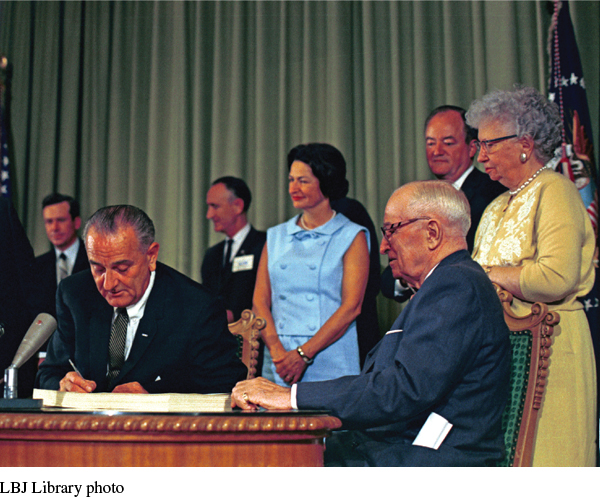The Great Society
In an address at the University of Michigan on May 22, 1964, President Johnson sketched out his dream for the Great Society, one that “rests on abundance and liberty for all. It demands an end to poverty and racial justice, to which we are totally committed in our time. But that is just the beginning.”
Besides poverty and race, he outlined three broad areas in need of reform: education, the environment, and cities. Toward this end, the Elementary and Secondary School Act (1965) was the most far-reaching federal law ever passed. It provided federal funds directly to public schools to improve their quality. The Model Cities program (1966) set up the Department of Housing and Urban Affairs, which coordinated efforts at urban planning and rebuilding neighborhoods in decaying cities. The Department of Transportation sought to ensure a fast, safe, and convenient transportation system. In addition, the president pushed Congress to pass hundreds of environmental protection laws, including those dealing with air and water pollution, waste disposal, the use of natural resources, and the preservation of wildlife and wilderness areas. Still, it was the War on Poverty that garnered the most attention.

The opening salvo of the War on Poverty came with passage of the Economic Opportunity Act of 1964. Through this measure, Johnson wanted to offer the poor “a hand up, not a handout.” Among its major components, the law provided job training, food stamps, rent supplements, redevelopment of depressed rural areas, remedial education (later to include the preschool program Head Start), a domestic Peace Corps called Volunteers in Service to America (VISTA), and a Community Action Program that empowered the poor to shape policies affecting their own communities. Between 1965 and 1968, expenditures targeted for the poor doubled, from $6 billion to $12 billion. The antipoverty program helped reduce the proportion of poor people from 20 percent in 1963 to 13 percent five years later, and it helped reduce the rate of black poverty from 40 percent to 20 percent during this same period.
Johnson intended to fight the War on Poverty through the engine of economic growth, which would create new jobs for the unemployed without redistributing wealth. With this in mind, he persuaded Congress to enact significant tax cuts. Johnson’s tax cut, which applied across the board, stimulated the economy and sent the gross national product soaring from $591 billion in 1963 to $977 billion by the end of the decade. Despite the gains made, many liberals believed that Johnson’s spending on the War on Poverty did not go far enough. Whatever the shortcomings, Johnson campaigned on his antipoverty and civil rights record in his bid to recapture the White House in 1964. His Republican opponent, Senator Barry M. Goldwater of Arizona, personified the conservative right wing of the Republican Party. The Arizona senator condemned big government, supported states’ rights, and accused liberals of not waging the Cold War forcefully enough. His aggressive conservatism appealed to his grassroots base in small-town America, especially in southern California, the Southwest, and the South. His tough rhetoric, however, scared off moderate Republicans, resulting on election day in a landslide for Johnson as well as considerable Democratic majorities in Congress.
Flush with victory, Johnson pushed Congress to move quickly. Working together, they achieved impressive results. To cite only a few examples, the Eighty-ninth Congress (1965–1967) subsidized health care for the elderly and the poor by creating Medicare and Medicaid, expanded voting rights for African Americans in the South, raised the minimum wage, and created national endowments for the fine arts and the humanities. The 1965 Immigration Act repealed discriminatory national origins quotas established in 1924, resulting in a shift of immigration from Europe to Asia and Central and South America (Table 26.1).
| Year | Legislation or Order | Purpose |
| 1964 | Civil Rights Act | Prohibited discrimination in public accommodations, education, and employment |
| Economic Opportunity Act | Established War on Poverty agencies: Head Start, VISTA, Job Corps, and Community Action Program | |
| 1965 | Elementary and Secondary Education Act | Federal funding for elementary and secondary schools |
| Medical Care Act | Provided Medicare health insurance for citizens sixty-five years and older and Medicaid health benefits for the poor | |
| Voting Rights Act | Banned literacy tests for voting, authorized federal registrars to be sent into seven southern states, and monitored voting changes in these states | |
| Executive Order 11246 | Required employers to take affirmative action to promote equal opportunity and remedy the effects of past discrimination | |
| Immigration and Nationality Act | Abolished quotas on immigration that reduced immigration from non-Western and southern and eastern European nations | |
| Water Quality Act | Established and enforced federal water quality standards | |
| Air Quality Act | Established air pollution standards for motor vehicles | |
| National Arts and Humanities Act | Established National Endowment of the Humanities and National Endowment of the Arts to support the work of scholars, writers, artists, and musicians | |
| 1966 | Model Cities Act | Approved funding for the rehabilitation of inner cities |
| 1967 | Executive Order 11375 | Expanded affirmative action regulations to include women |
| 1968 | Civil Rights Act | Outlawed discrimination in housing |
Exploring American HistoriesPrinted Page 869
Exploring American Histories Value EditionPrinted Page 643
Chapter Timeline